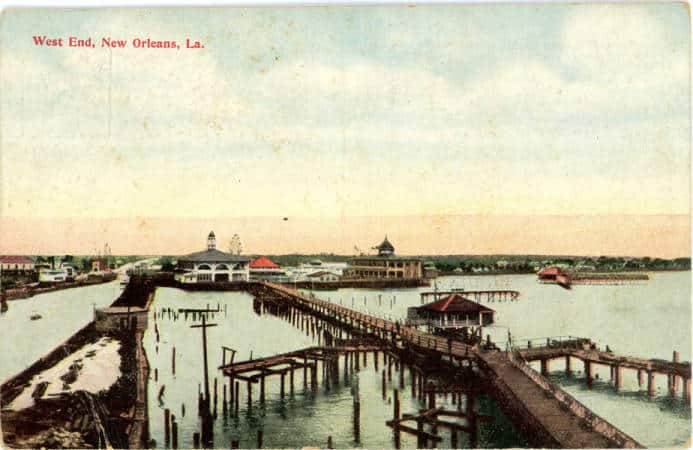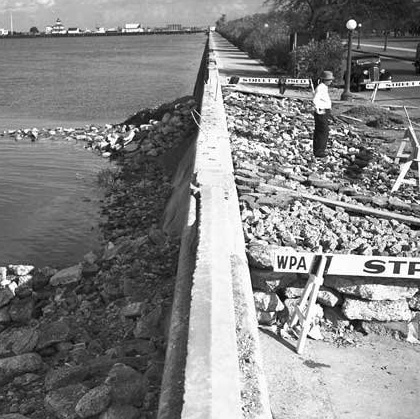The Story of West End
Head to West End today, and you’ll feel the history just beneath your feet. Sailboats bob in the harbor, seafood platters steam out of bustling kitchens, and holiday lights ripple across the lake during the annual boat parade. Families gather under the oaks for picnics, kids splash near the West End Park fountain, and music, laughter, and memories ride every breeze.
But this lakeside gem, a uniquely New Orleans blend of music, food, and water, didn’t always look like this. What you see today is the latest chapter in a story nearly two centuries in the making.
From Customs Post to Coastal Playground
Back in the 1830s, what we now call West End was known as New Lake End, part of the then-town of Carrollton. It wasn’t yet a part of New Orleans, but it played an outsized role in the region’s maritime life. Small schooners from Havana and other ports would dock here, making it an official U.S. port of entry, complete with customs agents.
Commerce wasn’t the only draw, though. New Lake End was one of three popular lakefront escapes, alongside Milneburg and Spanish Fort, where residents came to escape the summer heat, stretch their legs, and find a reprieve from the yellow fever epidemics that often gripped the city.
When a rail line opened in 1853, it connected Carrollton directly to the lakefront, making this area more accessible than ever and sparking the birth of a neighboring settlement known as Bucktown.
By the 1880s, the place was booming. Resorts popped up along the water. The Southern Yacht Club, one of the oldest in the country, established its clubhouse here. Around this time, the neighborhood adopted a new name: West End, a nod to London’s renowned theater district. It was a fitting choice. With music, dining, and lively crowds, West End was quickly becoming a stage all its own.
The Heyday
In the late 19th and early 20th centuries, West End became what could be considered as the Coney Island of New Orleans. Built on pilings over the lake, it offered a dazzling mix of roller coasters, flying horses, moonlit cruises, and open-air dance halls. For just 15 cents, a round-trip streetcar ride could carry you from the city to an unforgettable lakeside night.
Perhaps most enduring was the music.
From ragtime to early jazz, West End was a cradle of American sound. You could hear orchestras in the park’s gazebo, Mexican marching bands near the boardwalk, or jazz legends like Louis Armstrong, King Oliver, Kid Ory, and Sidney Bechet playing roadhouses after hours. This is where “cutting contests” took center stage, duels of improvisation that propelled jazz into new territory.
Reimagining the Lakefront
In the 1910s, amid a wave of urban improvements, New Orleans engineers transformed the area again. A large coffer dam was constructed to hold back the lake while sediment was pumped in to raise the land. The result was West End Park, with winding lagoons, scenic footbridges, and a new kind of marvel: the Darlington Electric Prismatic Fountain.
Designed by F.W. Darlington, a pioneer in electrical fountain choreography, this 1915 installation combined light, motion, and music in a way the city had never seen. It was the crown jewel of the park, a dancing fountain that seemed to capture the rhythm of West End itself.
Changing Currents: The Years Between
For decades after the creation of West End Park and the debut of the Darlington Fountain, the area remained a beloved destination. From the 1920s through the 1950s, West End thrived as a gathering place for locals and visitors alike. Restaurants bustled with patrons feasting on freshly caught seafood, and weekends brought families to the lakefront for leisurely strolls, music-filled evenings, and colorful fountain displays.
As the city expanded and the automobile redefined how people traveled and gathered, West End’s role in everyday life began to shift. New entertainment districts emerged, and urban renewal projects in the 1960s and ’70s changed the rhythm of the neighborhood. Infrastructure aged. Public investment waned.
The Darlington Fountain, once a marvel of light and motion, suffered from neglect. Though it flickered back to life briefly after a partial renovation in the 1970s, the momentum didn’t last.
Storms, Silence, and the Promise of Return
As time passed, West End’s luster dimmed. Restaurants closed. The music faded. The Darlington Fountain stopped flowing. And then came Hurricane Katrina, delivering a final, devastating blow.
In 2009, just a few years after Katrina, a group of neighbors, business owners, historians, and park lovers came together with a shared belief: The West End was worth saving. That it deserved to be remembered, restored, and reimagined for future generations.
They formed Friends of West End—a nonprofit dedicated to preserving the area’s rich history, restoring its landmarks, and promoting its vibrant future.
West End is powered by a diverse community of stakeholders, including:
What Makes Us Different
Friends of West End is a registered 501(c)(3) nonprofit created by the very people who live and work here.
We’re not just planning for West End’s future – we live it. We work hand-in-hand with:
- Local families and business owners
- City planners and public agencies
- Volunteers, donors, and people like you
Why We Need You Now
Preserving the Past. Shaping the Future.
Whether you’re a lifelong resident, a history lover, or someone who simply believes in protecting New Orleans’ beauty, there’s a place for you here.
Restoring West End isn’t just about rebuilding a park or reviving a fountain. It’s about preserving a legacy, strengthening community ties, and protecting one of New Orleans’ most iconic waterfront neighborhoods. The restoration of the Darlington Fountain is just the beginning.
Thanks to a generous grant from the The Azby Fund, the Darlington Fountain has been carefully assessed, its blueprints rediscovered, and its story brought back to life through a new documentary: “West End and the Dancing Prismatic Fountain.”
Every Friend Counts
Your Support Helps Us:
As we bring this historic structure back to life, we’re also laying the groundwork for continued restoration, community programming, and public access initiatives. If you believe public space is sacred, cultural heritage is worth preserving, and community is built by all of us – join us.
Be part of something lasting. Be part of something local. Be a Friend of West End.
The West End belongs to all of us: past, present, and future. Your support brings life back to a beloved place and ensures it remains vibrant for all who follow.

West End
New Orleans, Louisiana




